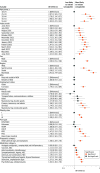Factors Associated With Semaglutide Initiation Among Adults With Obesity
- PMID: 39836425
- PMCID: PMC11751746
- DOI: 10.1001/jamanetworkopen.2024.55222
Factors Associated With Semaglutide Initiation Among Adults With Obesity
Abstract
Importance: Semaglutide, a novel glucagon-like peptide-1 (GLP-1) receptor agonist medication, was approved for weight management in individuals with obesity in June 2021. There is limited evidence on factors associated with uptake among individuals in this subgroup without diabetes.
Objective: To explore factors associated with semaglutide initiation among a population of commercially insured individuals with obesity but no diagnosed diabetes.
Design, setting, and participants: This retrospective observational cohort study used data from the Merative MarketScan Commercial Claims and Encounters Database and included adults in the US aged 18 years or older with a first diagnosis of obesity in an outpatient or inpatient setting between June 5, 2021, and July 1, 2022. Inclusion criteria were no prior antiobesity medication, GLP-1, bariatric surgery, or diabetes-related claim in the 12 months prior to obesity diagnosis, and continuous enrollment in the 12 months preceding and 6 months following obesity diagnosis. Analysis was conducted from February to November 2024.
Exposures: Medication classes prescribed, clinical diagnoses, and sociodemographic factors. Exposures were identified within the 12 months prior to obesity diagnosis.
Main outcomes and measures: Factors associated with incident semaglutide prescription within 6 months after obesity diagnoses were identified using a 10-fold cross-classified random forest model. The top 20 features of the model feature importance list were ranked in a Shapley Additive Explanations plot and used in a multivariable logistic regression model to quantify associations with semaglutide initiation.
Results: In this study of 97 456 individuals, 58 124 (59.6%) were female, 26 582 (27.3%) were aged 45 to 54 years, 50 705 (52.0%) resided in the South region, and 49 390 (50.7%) were covered by preferred provider organization plans. Of all participants, 1963 (2.0%) initiated semaglutide within 6 months of their initial obesity diagnosis. The random forest model had an area under the receiver operating characteristic curve of 0.71 (95% CI, 0.69-0.74). The most important exposures identified via Shapley Additive Explanations were sex, use of antidepressants, and employer industry. The top 20 factors were used in the logistic regression model, and significant associations were found with semaglutide initiation, including being female (adjusted odds ratio [aOR], 2.30; 95% CI, 2.05-2.58), use of certain medication classes including antidepressants (aOR,1.62; 95% CI, 1.46-1.78), and being covered by a point-of-service plan (aOR, 1.78; 95% C, 1.42-2.22).
Conclusions and relevance: This cohort study found that key sociodemographic, health care, and clinical factors are associated with receipt of semaglutide in those without diabetes. These findings suggest that insurance plan type and structure may be a crucial intervention point for improving equity in obesity treatment access.
Conflict of interest statement
Figures


References
-
- Montero A, Sparks G, Presiado M, Hamel L. KFF health tracking poll May 2024: the public’s use and views of GLP-1 drugs. KFF. Published May 10, 2024. Accessed May 21, 2024. https://www.kff.org/health-costs/poll-finding/kff-health-tracking-poll-m...
-
- National Center for Health Statistics . Obesity and overweight. Centers for Disease Control and Prevention. Updated October 25, 2024. Accessed December 5, 2024. https://www.cdc.gov/nchs/fastats/obesity-overweight.htm
-
- Lee CJ, Clark JM, Asamoah V, Schweitzer M, Magnuson T, Lazo M. Prevalence and characteristics of individuals without diabetes and hypertension who underwent bariatric surgery: lessons learned about metabolically healthy obese. Surg Obes Relat Dis. 2015;11(1):142-146. doi: 10.1016/j.soard.2014.06.012 - DOI - PMC - PubMed
Publication types
MeSH terms
Substances
LinkOut - more resources
Full Text Sources
Medical

